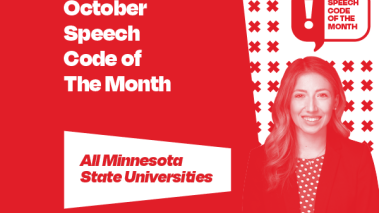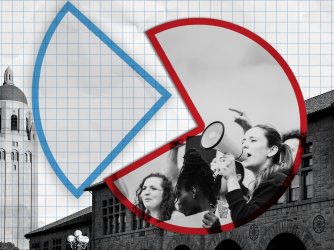Table of Contents
New systemwide harassment policy puts all Minnesota State universities in the red

FIRE
All of the colleges and universities in the Minnesota State system will plummet to the bottom of FIRE’s Spotlight database of speech code ratings following the Board of Trustees’ adoption of a highly restrictive harassment policy.
The policy, which fails to track the Supreme Court’s standard for peer harassment in several critical ways, encompasses speech protected by the First Amendment, and must be revised. Accordingly, this policy is FIRE’s Speech Code of the Month for October.
Unfortunately, when it comes to harassment policies, it is not uncommon for universities to adopt policies that fall short of the standard set by the Supreme Court. However, it is far less common for public universities, bound by the First Amendment, to adopt harassment policies that make almost no attempt to reflect that standard at all. But, here, that seems to be the case.
According to the Supreme Court in Davis v. Monroe County Board of Education (1999), peer (student on student) harassment is conduct that is “so severe, pervasive, and objectively offensive, and that so undermines and detracts from the victims’ educational experience, that the victim-students are effectively denied equal access to an institution’s resources and opportunities.”
In contrast, the Minnesota State policy defines harassment as any unwelcome communication, based on membership in a protected class, that “has a negative effect or is likely to have a negative effect on the complainant or the workplace or educational environment.”
What does this mean? The systemwide harassment policy adopted by Minnesota State universities:
- does not require conduct to be severe, pervasive, and objectively offensive to be considered discriminatory or sexual harassment;
- does not require the conduct rise to the level of effectively denying equal access to an institution’s resources and opportunities; and
- appears to merge employment harassment and peer harassment, which have two different standards, into one policy by including conduct that has a negative effect on the “workplace.”
Our concerns don’t end there. The policy also lists examples of expression it considers harassment, the vast majority of which do not always rise to the level of harassment and are often considered protected speech. For example, the policy lists “negative comments” about “cultural norms,” jokes, innuendos, gestures, visual displays with derogatory meanings such as screen savers, among plenty of other expressive activity, as examples of conduct that constitute harassment.
Examples like these could discourage students from engaging in debate on important topics. For example, in 2019, the Peace Corps published an article on its website entitled “Challenging Cultural Norms to Inspire Girls and Women.” Similarly, in 2015, the Guardian published an article entitled “Challenging cultural norms is the first step towards gender parity in India.” Would topics like these, which seem to celebrate challenging cultural norms, count as negative comments? It’s a question we don’t know the answer to.
What we do know is that this newly adopted system wide policy so substantially interferes with free speech that it earns FIRE’s worst, “red light” rating, and will tank the ratings of all of the Minnesota State system universities included in FIRE’s Spotlight Database.
FIRE urges the Minnesota State Board of Trustees to revise its harassment policy to reflect the Davis standard, and to create a separate policy for employee harassment.
The policy’s deviations from the legal standard for harassment pose a number of issues for protecting free speech rights on campus. Aside from being overinclusive by punishing conduct that does not rise to the level of harassment, it is also impermissibly vague. When students are unsure whether their speech could be considered negative, they may self-censor, meaning the policy would risk causing an impermissible chilling effect on speech. Further, vague policies allow administrators to punish conduct subjectively and discriminate against speech based on viewpoint.
While less than a quarter of campuses nationwide receive a red light rating from FIRE, 100% of Minnesota State universities will now earn FIRE’s worst rating. Fortunately, all these red light ratings can be easily improved by changing one policy.
FIRE urges the Minnesota State Board of Trustees to revise its harassment policy to reflect the Davis standard, and to create a separate policy for employee harassment.
If the revised policy continues to include protected speech as examples of punishable harassment, the policy should specify that the expression listed will only be punished if it rises to the level of unlawful peer harassment. We are happy to assist Minnesota State in this endeavor to ensure students’ free speech rights remain protected.
Recent Articles
FIRE’s award-winning Newsdesk covers the free speech news you need to stay informed.

A third of Stanford students say using violence to silence speech can be acceptable

Stanford president and provost cheer free expression in open letter to incoming class

FIRE survey shows Judge Duncan shoutdown had ‘chilling effect’ on Stanford students


